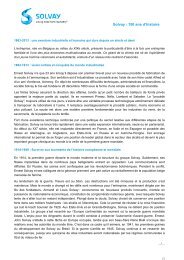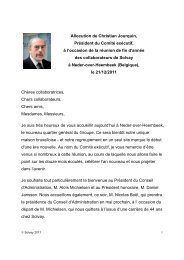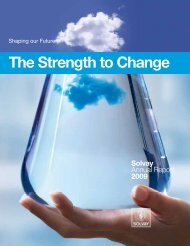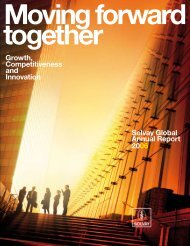solvay_live243_p02a04 somEdito
solvay_live243_p02a04 somEdito
solvay_live243_p02a04 somEdito
You also want an ePaper? Increase the reach of your titles
YUMPU automatically turns print PDFs into web optimized ePapers that Google loves.
Dossier<br />
104188<br />
48<br />
USING MELTCRYSTALLIZATION INSTEAD<br />
OF ACETONE CRYSTALLIZATION<br />
FOR PURIFICATION OF CHOLESTEROL<br />
GREATER PURITY<br />
WITHOUT SOLVENTS<br />
SolvayInnovationTrophy2006<br />
Crystallisation is a classic chemical process<br />
that is used to isolate and purify the<br />
end-products. The traditional processes,<br />
which use solvents, are heavy users of<br />
energy, which is required for the evaporation<br />
of the solvents. The subsequent<br />
indispensable stages involving the filtration<br />
and washing of the crystals obtained are also<br />
difficult to control. The innovation consists<br />
on directly doing the crystallization from the<br />
melted product, therefore without using<br />
solvents. The crystals separate naturally from<br />
the impurities. By repeating the operation<br />
several times, we can obtain a product<br />
of a very high purity. This process has been<br />
developed with an external partner<br />
(Sulzer/Switzerland) and has proved to be<br />
effective for the purification of cholesterol.<br />
When applied to other products under study<br />
in the Group, for an equivalent level<br />
of production, compared with acetone<br />
crystallisation, meltcrystallization:<br />
• consumes less energy;<br />
• costs less in terms of equipment;<br />
• is safer (no solvent);<br />
• is less labour-intensive;<br />
• is more productive.<br />
> Hans Hoogendijk; Jeffrey Felix.<br />
> PHARMACEUTICALS SECTOR<br />
101924<br />
OPTIMIZATION OF SOLVAY SOLOX PLANT<br />
THINKING OUTSIDE<br />
THE BOX LEADS<br />
TO CONCLUSIVE RESULTS!<br />
The production of epichlorhydrine in<br />
Rheinberg (Germany) uses large<br />
quantities of water, approximately 350 m3 per hour. The water is treated in the Solox<br />
plant to significantly reduce the CSB and<br />
AOX emissions. An improved method was<br />
developed to dramatically reduce the<br />
consumption of chlorine and bisulphate.<br />
This only required modifications to be made<br />
to the existing process. No major investment<br />
was needed. The original method also used<br />
a great deal of energy to heat the water up to<br />
130°C before mixing in the additives<br />
to destroy the organic compounds. Then<br />
the water has to be cooled down again.<br />
The new process is as simple as it is efficient.<br />
Simply changing the sequence in which the<br />
reactants are added reduces the time<br />
required to treat the organic AOX. This<br />
minimizes the consumption of chlorine<br />
and bisulphate. The emissions in the water are<br />
well below the statutory limits. The resulting<br />
savings of approximately EUR 390 000 per<br />
year have a significant effect on<br />
the profitability of the process. Finding<br />
the solution considerably benefited from<br />
the open-minded approach; a working group<br />
was able to positively question the existing<br />
experience and opinions and thus the<br />
successful solution to optimize the process.<br />
> Franz-Jozef Krekeler; Klaus Huecklekemkes;<br />
Frank Steffens.<br />
> SBU EDS<br />
104407<br />
AIR SHOWER FOR RAW MATERIALS,<br />
FINISHED PRODUCTS AND PERSONNEL<br />
A BREATH OF FRESH AIR<br />
Air showers, designed by the Engineering<br />
Department, have been installed for<br />
both personnel and products. It has been<br />
found that this is the best solution to meet<br />
the requirements of the production<br />
standards related to the access of personnel,<br />
their equipment and the materials into<br />
regulated production zones. The personnel<br />
walk into an airlock in which the filtered air<br />
is forced upwards at a high speed,<br />
eliminating the dust and other fibre residues.<br />
For the materials, the speed of the air is<br />
increased and the ionised air is even more<br />
efficient. Not only is the investment minimal,<br />
this system is also user-friendly,<br />
straightforward, completely safe,<br />
environmentally-friendly and can be installed<br />
in only six to eight weeks. Furthermore,<br />
the original design of the system facilitates<br />
compliance with the GMP manufacturing<br />
standards. It also makes it possible to cut<br />
down on the number of persons working in<br />
the production zones, as, without this kind<br />
of system, the standards require one person<br />
per product, with a specific type<br />
of equipment, for each working zone.<br />
> Aurea Xumetra; Juan Carlos Correa; Oscar Roig;<br />
Jesús Manuel Vega.<br />
> PHARMACEUTICALS SECTOR


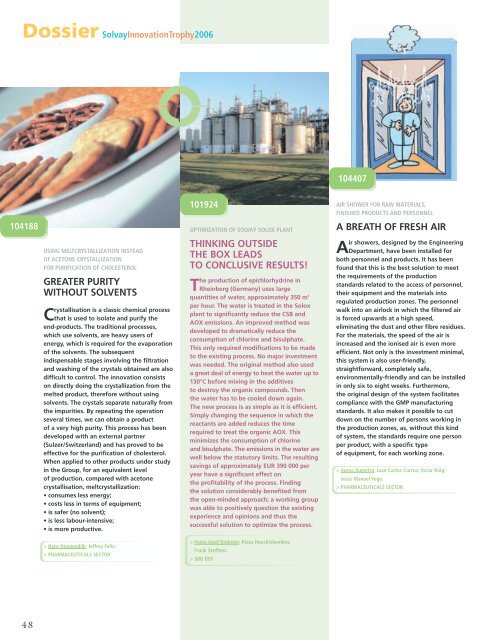

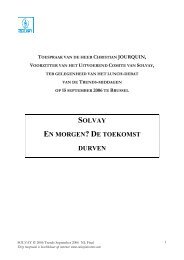
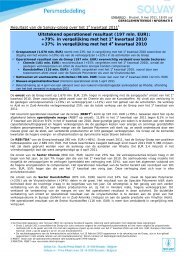

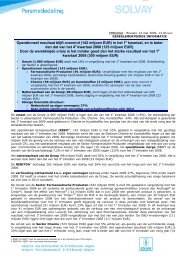
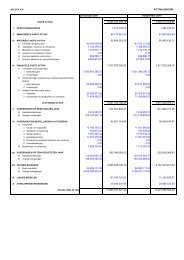

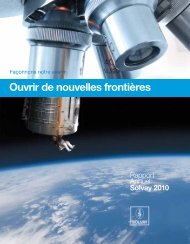
![PROC.1 [LETTRE] - Solvay](https://img.yumpu.com/16585746/1/184x260/proc1-lettre-solvay.jpg?quality=85)
